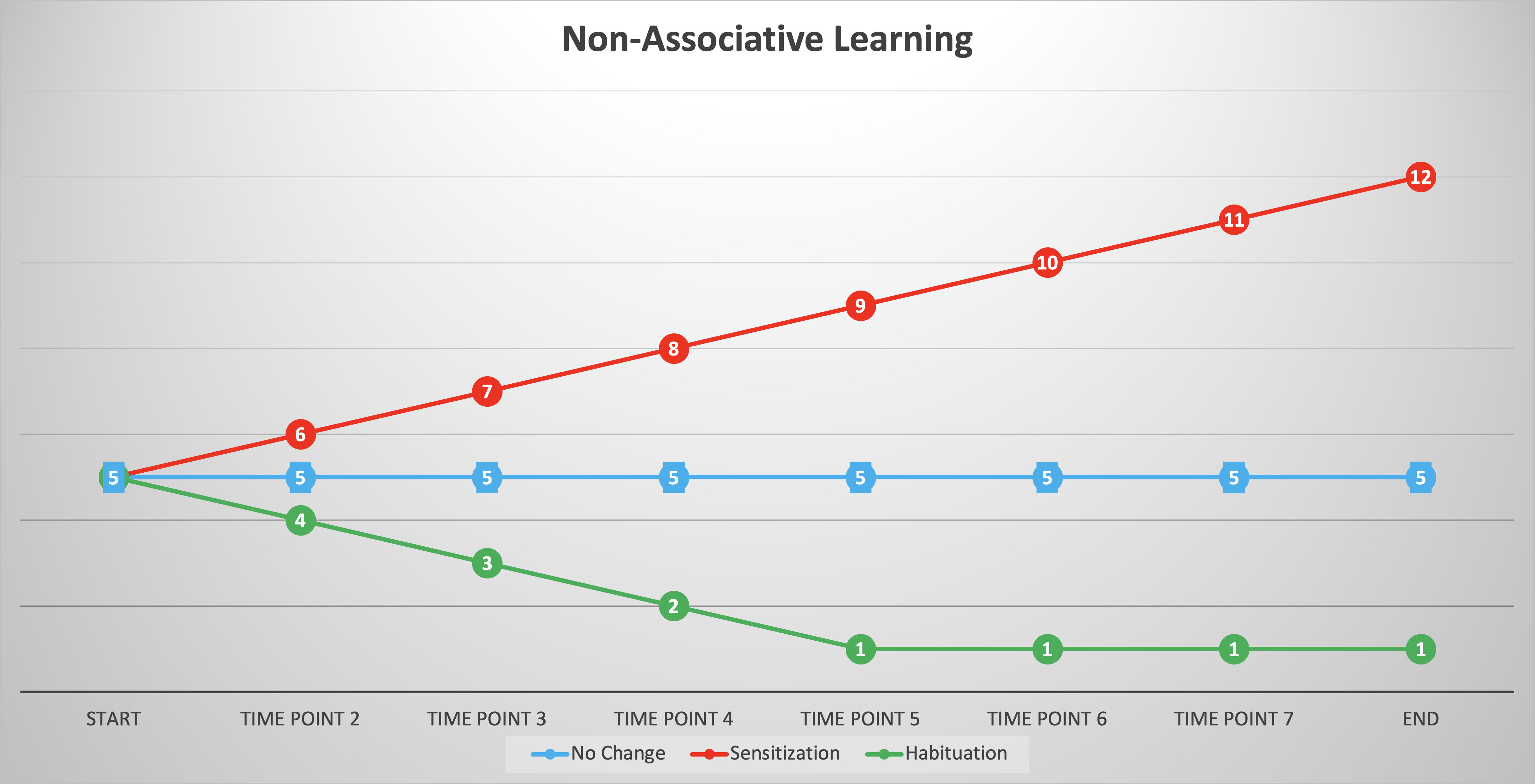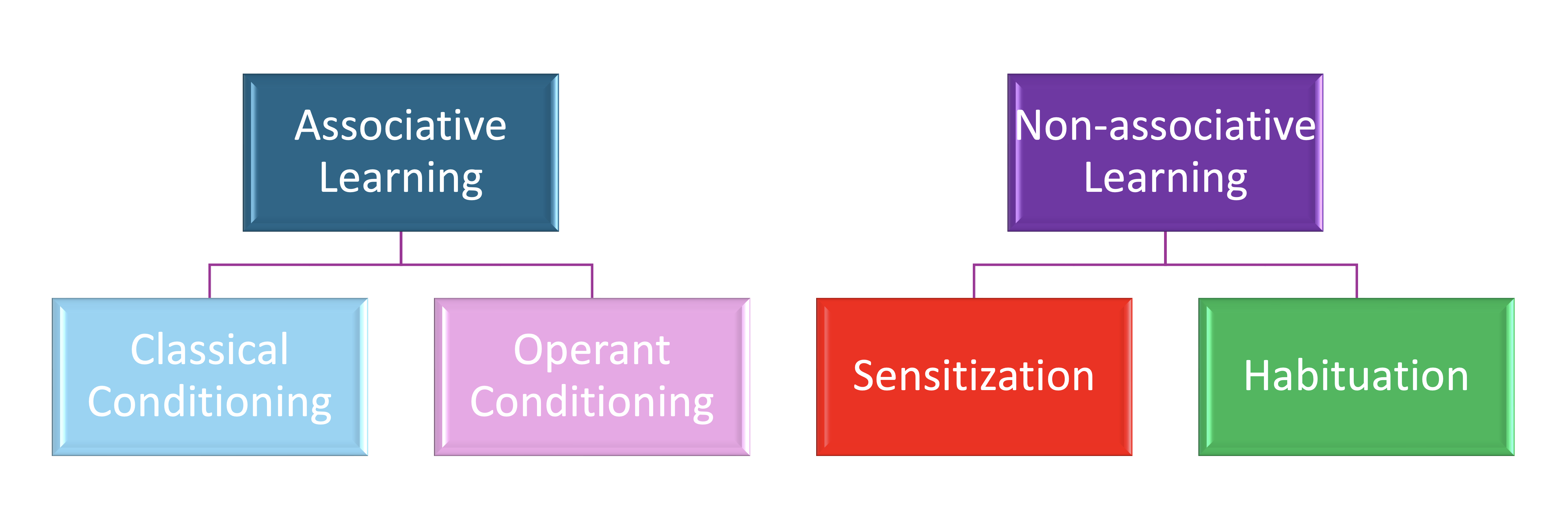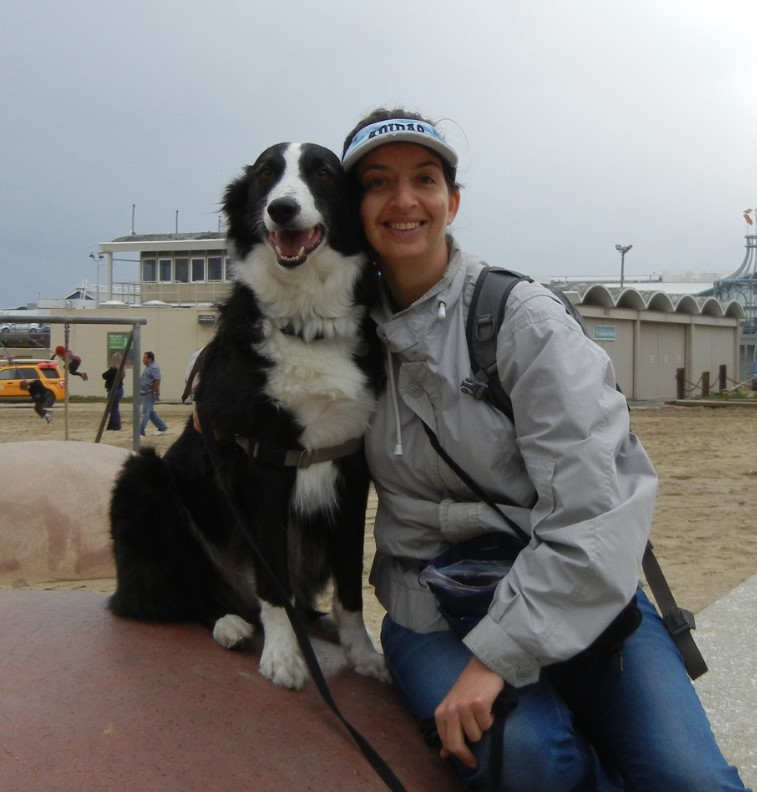NOTE: This sample lecture is an example of a geeky "knowledge" lecture. There will also be more "practical" lectures with suggested exercises students can use to explore these geeky concepts!
NOTE: Want to watch a video of this lecture instead of reading it? Click on the video above!
Hi everyone! I'm Irith Bloom, and this is Fenzi Dog Sports Academy BH245: Getting Geeky About Behavior Change.
Non-Associative Learning
In this lecture I'm going to be talking about non-associative learning, which is a type of learning that some of you may not be familiar with.
Associative Learning
Before going into the topic of non-associative learning, I want to quickly review associative learning, which is a type of learning that many of you are likely familiar with, even if you don't necessarily know this specific term.
Classical Conditioning and Operant Conditioning
Associative learning comes in two form, classical conditioning and operant conditioning.
Both classical and operant conditioning are covered in greater depth in other lectures, so I'm not going to go into them in depth in this lecture, but I am going to delve a bit into why they are both forms of associative learning.
In associative learning, associations are being made, and they may be positive or negative associations.
As the name implies, associative learning has to do with making associations.
Negative Associations
Some of those associations may be negative.
For example, if every time an animal sees a motorcycle, they receive a shock, they may come to associate motorcycles with shock and have a negative association and likely negative emotions associated with motorcycles.
Similarly, if every time an animal jumps up they receive a shock, they're likely to associate the behavior of jumping up with the consequence of getting a shock and they will form a negative association. And it is possible that the shock will punish the jumping up and you'll see less jumping up.
The first example of the motorcycle and and the shock is a classical conditioning association. The two stimuli happen at about the same time and the animal forms an association between them.
The second example of the animal jumping up in the shock is an operant conditioning association where the animal associates its behavior with a consequence.
Positive Associations
Not all associations are negative, of course. Animals also form positive associations.
For example, if when the animal saw motorcycles, they got a treat each time, they would start to associate the presence of motorcycles with treats and they would have positive associations with motorcycles and likely have a positive emotional responseto the presence of a motorcycle.
Similarly, if every time the animal goes to a mat they get a treat, they're going to associate going to a mat with getting a treat. The behavior of going to a mat gets associated with the positive consequence of getting a treat and they will have a positive association with the behavior of going to the mat.
Back to Non-Associative Learning
That brings us to non-associative learning.
The key point with non-associative learning is that there aren't clear associations between between different stimuli.
Non-associative Learning is divided into two main categories. The two forms of non-associative learning are known as sensitization and habituation. I'm going to use this little graphic of non-associative learning to help explain habituation and sensitization.

Example Scenario for This Discussion
An example may help make things clearer. The example I will use is that of an animal that is inside a home with the windows closed and the shades down when fireworks are happening in the neighborhood. So there are loud boom booms happening, but there's nothing else. There's no smell of fireworks. There are no flashes of light. It's just these sudden loud noises.
Three Possibilities: No Change, Sensitization, Habituation
There are three things that can happen in a situation like that where there are these loud booms happening.
Let's start by assuming that the first time the boom happens, the animal has some kind of startle response, which is a very normal and typical thing to happen. And let's say for the sake of our conversation here that their startle response is a 5 on some random scale.
No Change
One of the things that can happen is that there is absolutely no change in the animal's behavior as the fireworks go on.
The first time they heard a firework, their startle was at a level five. Next time, same level five. Next time, same level five. And the time after that, still the same level five. That's the blue line that you see in the middle, where you see it's 5 5-5-5-5 -- all the way across the line stays flat. And there is no change in the animal's behavior. That is one possibility.
Sensitization

Another possibility is that sensitization will occur.
Sensitization in this image is shown in the red line, which is the line that goes from being at a 5 in the lower left side to being at a 12 in the upper right side.
With sensitization, what you would observe as you watch the animal is that when that first firework goes off, they have that same startle we mentioned before, at level five. But then when the next firework goes off, their startle is even bigger -- we could call it a level six. Then the one after that, the startle goes up to a level seven, and the next one after that to a level eight, and so on and so on until the animal is having massive reactions to the fireworks that are much bigger than they were when they heard the first Firework.
Essentially, what's happening is the animal is becoming more sensitized to the fireworks, more sensitive to them. They're reacting more and more.
Again, this is called sensitization.
Sensitization is something that in general we really don't want to see a lot of, because it means the animal overreacts more and more to the stimulus.

Habituation
There's one other possibility in this situation in terms of non-associative learning, which is what we call habituation.
Habituation is the green line that goes down as you follow the chart. So on the right side of the chart, it's down at a level one.
With habituation, as you observe the animal, what you would see is that the first startle at the fireworks was still a level five. But then when the next firework goes off, their startle is smaller and milder -- it's just a level four. And after that it's a level three. And then it's a level two. And after a few fireworks, the animal is just going about their day almost as if they don't even hear the fireworks going on.
That is called habituation, and that is something that we do like to see.
Quick Recap
Again, there are three options here.
- There is the possibility that the fireworks go off, and there's no change in the startle response of the animal as the fireworks go on.
- There's the possibility that as the fireworks go on, the animal's response will get bigger and bigger. We call that sensitization.
- There's the possibility that as the fireworks go off, the animal's response will get to be less and less and they will become completely nonchalant about the fireworks. We call that habituation.
Reminder: Habituation and Sensitization are Non-Associative Learning
The reason we call both habituation and sensitization non-associative learning is because there's no consistent pairing or association of one stimulus with another that is responsible for changing the animal's response. The sound of the firework is happening, and then what happens afterwards is random.
For classical conditioning associations to form, we need a consistent pairing -- the firework happens and then something good happens, or the firework happens and then something bad happens.
But that's not happening here, because what happens after the fireworks is random. There's no consistent pairing.
Similarly, there's no reinforcement or punishment. Nobody is observing the animal's startle response and then feeding them a treat to make that startle response bigger. Nobody is observing the animal's startle response and then shocking the animal to punish that startle and make the startle response smaller.
And yet the behavior is changing. It's getting more extreme or less extreme, even though there is no reinforcement or punishment. So no operant conditioning associations are happening, but the behavior is changing anyway.
Learning is taking place, but it's not taking place as a result of associations between the stimulus of the firework and some other stimulus.
Why Does This Matter?
If non-associative learning is "just happening" and basically outside our control -- there's no pairing of stimuli like in classical conditioning, there are no punishers and reinforcers like in operant conditioning, the behavior is just changing through non-associative learning -- why should we care?
Non-Associative Learning Can Affect Associative Learning
The reason we should care is that non-associative learning can affect associative learning.
In other words, the things that the animal has learned through non-associative learning can make our training more or less effective and can change the associations that are formed when we're doing classical conditioning and operant conditioning.
For example, with an animal who is sensitized to fireworks during fireworks season, that animal is going to be more stressed. Stress affects an animal's ability to learn. That means that whatever classical conditioning or operant conditioning we are trying to do with that animal is likely to be less effective during fireworks season.
Another consideration is that there is a possibility that non-associative learning is happening even while we are consciously working on associative learning processes -- when we're doing classical conditioning, when we're doing operant conditioning. I'm sure you can imagine how if an animal is sensitizing or habituating to something while we are doing training, there could be times when when that would interfere with our goals.
It Pays to Be Aware of Non-Associative Learning
The bottom line is that we should at the very least be aware of what kind of non-associative learning is happening with our animal. There may also be times when we want to take steps to help prevent the wrong kind of non-associative learning.
Quick Overview of Types of Learning

Let's quickly review the types of learning that we've discussed in this lecture.
We've talked about associative learning, which is marked in blue above, and non-associative learning, which is marked in purple.
In associative learning, we have classical conditioning and operant conditioning, and in non-associative learning, we have sensitization and habituation.
This lecture has focused on the right side of this slide -- on the non-associative learning. Other lectures go into associative learning in greater depth.
Key Takeaways
Here are the key takeaways from this lecture:
- Not all learning involves associations between stimuli.
- Non-associative learning can be very powerful.
- Non-associative learning interacts with associative learning and can have an impact on associative learning.
- Paying attention to non-associative learning is important for us.
- It's a good idea to pay attention to what's happening with non-associative learning in daily life.
- Also pay attention to whether non-associative learning is happening during training, which is always a possibility.
- Awareness of non-associative learning is key to success, no matter what you want to do with an animal.
Next Steps
Gold and Silver Students
- Think about when non-associative learning is happening for your animal.
- Which type of non-associative learning is it?
-
- Is it habituation?
- Is it sensitization?
- Share your thoughts and ideas.
- Post questions and videos
Bronze Students
- Follow along.
- Try this at home with the animals you live with.
Thank you so much! I'll see you next time!
 Instructor: Irith Bloom
Instructor: Irith Bloom



